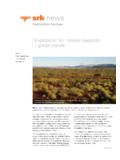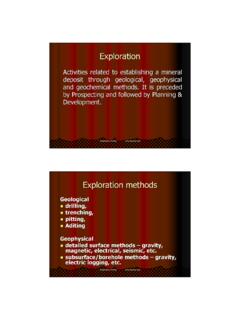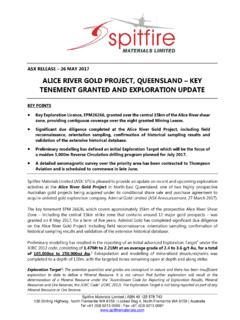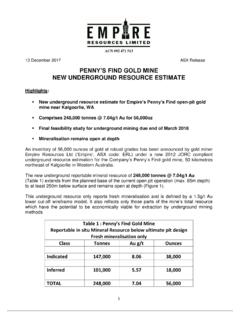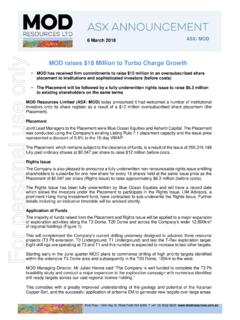Transcription of Quarterly Activities Report - Iron Road
1 Quarterly Activities Report for the period ended 31 March 2012 About Iron Road Iron Road Limited was established to capitalise on the growing global demand for iron ore. Iron Road has a strong project portfolio including a development stage project with excellent infrastructure, complemented by early stage projects. Iron Road s principal project is the Central Eyre Iron Project (CEIP) in South Australia. A prefeasibility study has demonstrated the viability of a mining and beneficiation operation initially producing of iron concentrate for export. A definitive feasibility study is assessing production of 20-25 Mtpa of iron concentrates. Test work indicates that a coarse-grained, high grade, blast furnace quality concentrate may be produced at a grind size of -106 m grading 67% iron with low impurities. The Company has a multi-disciplinary Board and management team that are experienced in the areas of exploration, project development, mining, steel making and finance.
2 ASX Code IRD GPO Box 1164 Adelaide 5001 South Australia PO Box 485 Wudinna 5652 South Australia Tel: (08) 9200 6020 Fax: (08) 9200 6021 Email: Web: Iron Road continued its high level of Activities aimed at advancing the flagship Central Eyre Iron Project (CEIP), hosting South Australia s largest iron ore mineral resource. The Definitive Feasibility Study (DFS) continued with engineering design providers selected for the review phase. A$ million raised (before costs) to continue project development and commence the acquisition of key parcels of land. Highlights Central Eyre Iron Project Continuation of Definitive Feasibility Study (DFS) with award of Review Phase engineering packages to three well regarded engineering service providers. The Stage VII diamond drilling programme at Rob Roy continued with an exploration target of 400-700Mt magnetite gneiss at an estimated 16-18% iron1. Completion of three PQ size diamond holes at Murphy South and Rob Roy for metallurgical test work and ore characterisation.
3 Community engagement continued, including several focus group sessions and a general community meeting at Lock. Gawler Iron Project Completion of core logging and processing from the Stage II diamond drilling programme. Corporate A$ million before costs secured to continue project development and commence acquisition of key land. Figure 1 Stage VII diamond drilling at Rob Roy 1 It is common practice for a company to comment on and discuss its exploration in terms of target size, grade and type. The potential quantity and grade of an exploration target is conceptual in nature since there has been insufficient work completed to define the prospects as anything beyond exploration target. It is uncertain if further exploration will result in the determination of a Mineral Resource, in cases other than the Boo-Loo and Murphy South prospects. Page | 2 Projects South Australia Central Eyre Iron Project The Central Eyre Iron Project (663km2) is located on the Eyre Peninsula of South Australia and consists of three distinct prospects Warramboo, Kopi and Hambidge.
4 The project is located in a grain farming area with good infrastructure. Work during the Quarter focused on the Murphy South and Rob Roy prospects. Figure 2 CEIP Murphy South and Rob Roy prospects indicated Definitive Feasibility Study (DFS) Early Studies Several packages of work related to government approvals and mine lease submission continued with various engineering service providers. Provision of utilities, comparison of camp options, study of airport upgrade and other project Activities began during the Quarter. Sinclair Knight Mertz (SKM) has identified the alignment for a utilities corridor, considered water supply options, reviewed motive power options for the rail system and advanced various mine related base-line surveys and environmental investigations. Coffey Mining is progressing design of the tailing storage facility (TSF) and site geotechnical sampling, as well as Mineral Resource modelling. Further geotechnical testing for the TSF and mine design has recently commenced on Iron Road s lease near Warramboo.
5 Iron Road continues to work with ElectraNet for the transmission of power. A connection options Report submitted by ElectraNet is currently under review and consideration of potential sources of power has commenced through contacts with major suppliers. Page | 3 GHD has been awarded a study to compare locations for the construction camp and operations village. The study includes consideration of community benefits and concerns. Airborne LiDAR and photo mosaic flown over the mine site, infrastructure and transport corridors have facilitated planning and engineering studies. Sources of ballast for rail and aggregate for construction are being assessed at localities situated both near the mine and infrastructure corridors. Definitive Feasibility Study (DFS) Engineering Design Engineering and design service (EDS) providers were awarded packages for the DFS Review Phase during February 2012. A rigorous selection method allowed preferred EDS Providers to be selected for the three major DFS components: Coffey Mining mine design and scheduling, geotechnical and pit design, mine hydro-geology, handling overburden and tailings; Bateman for ore treatment facilities; and SKM infrastructure comprising electricity distribution, rail systems, water supply, concentrate stockyards and marine facilities at potential port.
6 The EDS providers have formulated and submitted their plans (scope, schedule and budget) for the DFS Engineering phase to be conducted through 2012. Magnetite cores and chips were composited to provide a bulk CEIP sample, which was treated at AMDEL s laboratories in Perth to obtain additional metallurgical information and create a bulk concentrate sample for iron ore marketing purposes (Figure 3). The preliminary results of this investigation have confirmed that the relatively coarse grind size can deliver a concentrate grade at about 67% iron with low impurities through commercial process operations. About 900kg of concentrate was obtained for use in sintering and handling test work. The coarse concentrate size distribution is also expected to lower power demand in milling operations by approximately 10-15%, compared to PFS estimates. A comprehensive ore variability program, to test the metallurgical response of ore zones which will occur during the early years of mining, is planned to commence in the current Quarter.
7 Three 82mm diameter cores have been drilled and logged to deliver about six tonnes of mineralised rock across the available domains, including low-grade mineralisation . The results of this program will support estimation of ore reserves and confirm equipment selection in the ore treatment plant. Figure 3 Ball mill feed of bulk CEIP sample at AMDEL Page | 4 Rob RoyStage VII Drilling ProgrammeScale500mPlanned Stage VII drill holeCompleted Stage VII drill hole Stage V & Stage I drill hole Geotechnical drill holeMetallurgical drill hole KEYABCDEFGHIJKS tage VII Resource Expansion Drilling Rob Roy The Stage VII drilling programme at Rob Roy (Murphy South eastern extension) continued with an exploration target of 400-700Mt magnetite gneiss with an estimated grade of 16-18% iron2. Drilling of this programme commenced following the completion of Stage VI Mineral Resource expansion and geotechnical drilling to the west of Murphy South (Figure 4).
8 The Stage VII drilling programme comprises 82 diamond drill holes totalling over 34,000m. Individual diamond holes range from 100m-700m in depth with drilling on a standard 200mx100m grid. This drilling programme evaluates the eastern extension of the Murphy South orebody over an area approximately 800m wide by 2,000m long, utilising diamond drilling of NQ2 core. Figure 4 Plan view of CEIP Boo-Loo, Murphy South and current Rob Roy Resource drilling programme Over 15,000m and 44 diamond drill holes of the current drilling programme have been completed and the same sequence of magnetite gneiss as exposed at Murphy South has been intersected (Figure 5). Figure 5 Plan view of CEIP Rob Roy Stage VII Resource drilling programme. 2 It is common practice for a company to comment on and discuss its exploration in terms of target size, grade and type. The potential quantity and grade of an exploration target is conceptual in nature since there has been insufficient work completed to define the prospects as anything beyond exploration target.
9 It is uncertain if further exploration will result in the determination of a Mineral Resource, in cases other than the Boo-Loo and Murphy South prospects. Stage VI Murphy SouthMineral Resource-770 MtStage II & IIIBoo-Loo / DolphinMineral Resource -328 MtStage VMurphy South Mineral Resource VIIRob RoyExploration Target-400-700Mt Page | 5 Cross-sections A, B, C, D and E are presented below and indicate continuation of the magnetite gneiss along strike and eastward from Murphy South with a significant shallowing of the dip of the sequence. This may allow for additional deep drill holes and an increase in the magnitude of the exploration target. Figure 6 (A) Section 563140mE Figure 7 (B) Section 563340mE Page | 6 Figure 8 (C) Section 563540mE Figure 9 (D) Section 563740mE Page | 7 Figure 10 (E) Section 563940mE Metallurgical Drilling Three vertical PQ drill holes targeting mineralisation within unweathered magnetite gneiss were drilled for metallurgical test work and ore characterisation of the Murphy South / Rob Roy orebody.
10 The holes totalled 1,111m. Processing of the PQ core as well as the down hole geophysical surveys is complete and the core has been despatched to metallurgy laboratories for test work. Research Sponsorship Iron Road has committed to a PhD project at the University of Adelaide, over three years. The project will be supervised by Prof Martin Hand and Dr Anthony Reid (Geological Survey of South Australia) and Assoc. Prof Karin Barovich. Funding will be met by a collaborative arrangement between the Geological Survey of South Australia, Iron Road and the University of Adelaide. Data collected will be used to develop models for the tectonic evolution of the northern Eyre Peninsula, enabling the mineral prospectivity of this region to be placed into a broader geodynamic framework. The project will be allied closely with work underway within the Geological Survey of South Australia and with the exploratory and development work of Iron Road, with the aim to both understand and develop the mineral prospectivity of the broader Eyre Peninsula.
